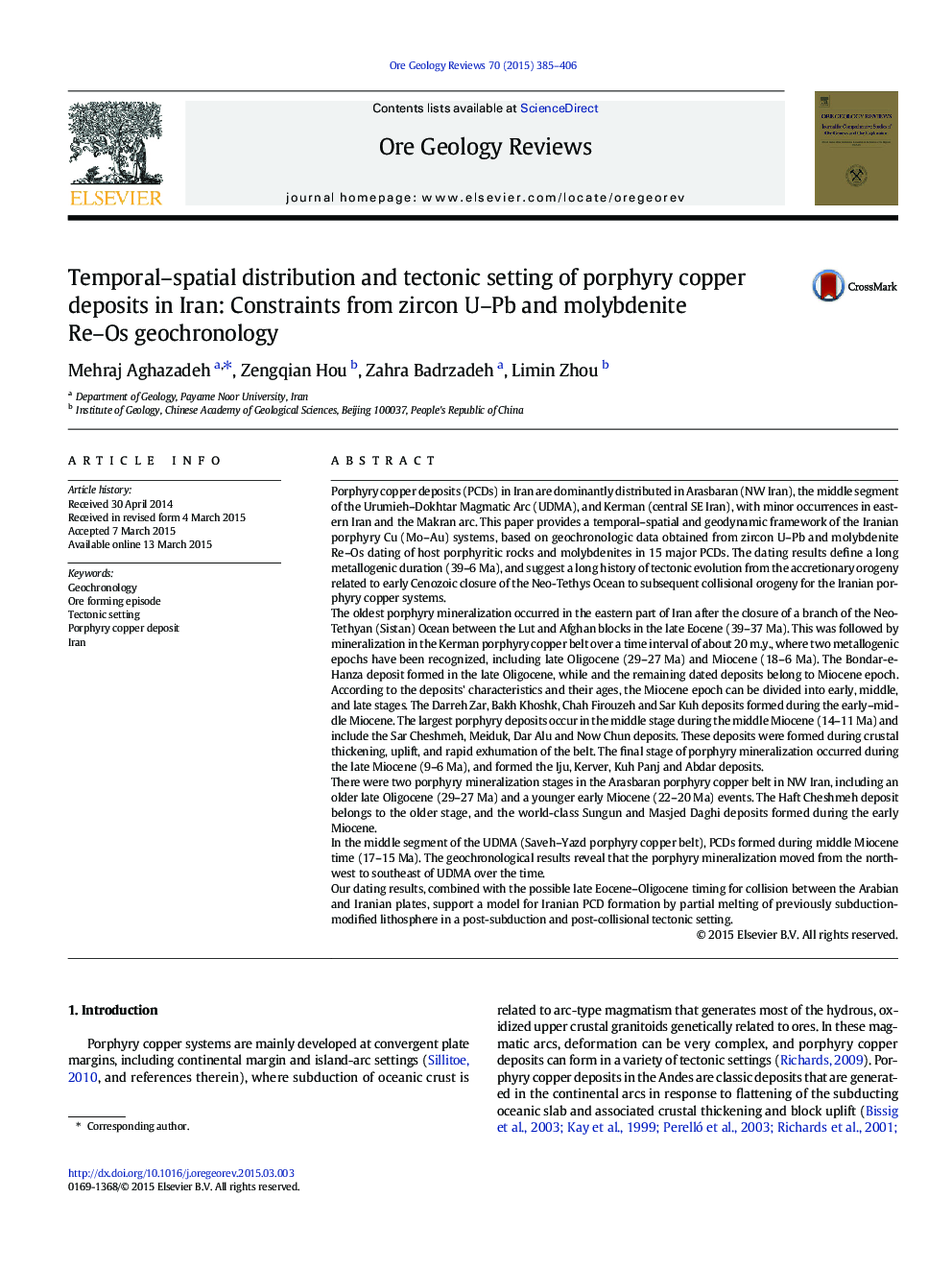| کد مقاله | کد نشریه | سال انتشار | مقاله انگلیسی | نسخه تمام متن |
|---|---|---|---|---|
| 4696987 | 1637234 | 2015 | 22 صفحه PDF | دانلود رایگان |
• Iranian PCDs were formed during long period from late Eocene to late Miocene.
• There are different belts with various epochs of porphyry copper mineralization in Iran.
• Porphyry mineralization moved along UDMA from NW to SE during time.
• Most of the PCDs in Iran have been formed in a post-collisional tectonic setting.
Porphyry copper deposits (PCDs) in Iran are dominantly distributed in Arasbaran (NW Iran), the middle segment of the Urumieh–Dokhtar Magmatic Arc (UDMA), and Kerman (central SE Iran), with minor occurrences in eastern Iran and the Makran arc. This paper provides a temporal–spatial and geodynamic framework of the Iranian porphyry Cu (Mo–Au) systems, based on geochronologic data obtained from zircon U–Pb and molybdenite Re–Os dating of host porphyritic rocks and molybdenites in 15 major PCDs. The dating results define a long metallogenic duration (39–6 Ma), and suggest a long history of tectonic evolution from the accretionary orogeny related to early Cenozoic closure of the Neo-Tethys Ocean to subsequent collisional orogeny for the Iranian porphyry copper systems.The oldest porphyry mineralization occurred in the eastern part of Iran after the closure of a branch of the Neo-Tethyan (Sistan) Ocean between the Lut and Afghan blocks in the late Eocene (39–37 Ma). This was followed by mineralization in the Kerman porphyry copper belt over a time interval of about 20 m.y., where two metallogenic epochs have been recognized, including late Oligocene (29–27 Ma) and Miocene (18–6 Ma). The Bondar-e-Hanza deposit formed in the late Oligocene, while and the remaining dated deposits belong to Miocene epoch. According to the deposits' characteristics and their ages, the Miocene epoch can be divided into early, middle, and late stages. The Darreh Zar, Bakh Khoshk, Chah Firouzeh and Sar Kuh deposits formed during the early–middle Miocene. The largest porphyry deposits occur in the middle stage during the middle Miocene (14–11 Ma) and include the Sar Cheshmeh, Meiduk, Dar Alu and Now Chun deposits. These deposits were formed during crustal thickening, uplift, and rapid exhumation of the belt. The final stage of porphyry mineralization occurred during the late Miocene (9–6 Ma), and formed the Iju, Kerver, Kuh Panj and Abdar deposits.There were two porphyry mineralization stages in the Arasbaran porphyry copper belt in NW Iran, including an older late Oligocene (29–27 Ma) and a younger early Miocene (22–20 Ma) events. The Haft Cheshmeh deposit belongs to the older stage, and the world-class Sungun and Masjed Daghi deposits formed during the early Miocene.In the middle segment of the UDMA (Saveh–Yazd porphyry copper belt), PCDs formed during middle Miocene time (17–15 Ma). The geochronological results reveal that the porphyry mineralization moved from the northwest to southeast of UDMA over the time.Our dating results, combined with the possible late Eocene–Oligocene timing for collision between the Arabian and Iranian plates, support a model for Iranian PCD formation by partial melting of previously subduction-modified lithosphere in a post-subduction and post-collisional tectonic setting.
Figure optionsDownload as PowerPoint slide
Journal: Ore Geology Reviews - Volume 70, October 2015, Pages 385–406
